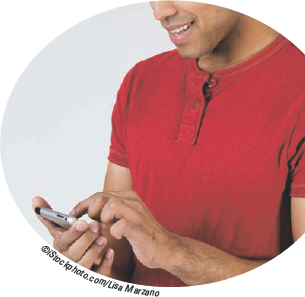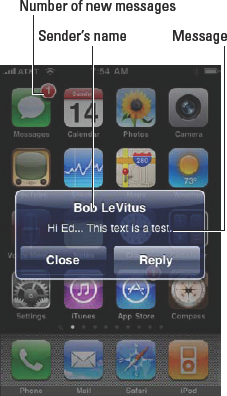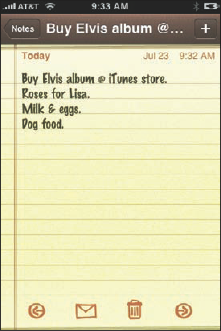Sending and receiving SMS (text) and MMS (multimedia) messages
Using the Notes application
Chances are this is your first experience with an intelligent virtual keyboard. In the beginning, it will probably feel awkward. Within a few days, however, many iPhone users report that they not only have become comfortable using it but have become proficient virtual typists as well.
By the time you finish this chapter, we think you'll feel comfortable and proficient, too. You discover all about using the virtual keyboard in Chapter 2. In this chapter, we focus on two iPhone applications that use text — namely, Messages and Notes.

The Messages application lets you exchange short text messages with any cell phone that supports the SMS protocol.
New in iPhone OS 3.0 is support for the MMS protocol, which lets you exchange pictures, contacts, videos, ringtones, and other audio recordings, and locations with any cell phone that supports the MMS protocol.
Note
SMS is the acronym for the Short Message Service protocol; MMS is the acronym for the Multimedia Messaging Service protocol. Most phones sold today support one or both protocols.
Warning
MMS support is built into iPhone OS 3.0 and higher and works with iPhone 3G and 3GS (but not the first-generation iPhone). And though it took awhile, Apple's exclusive wireless partner in the United States (AT&T) finally got around to enabling MMS in September 2009, long after this book was first published and long after numerous overseas wireless carriers offered MMS to iPhone customers. For what it's worth, we did offer to fly to Italy or Switzerland to research MMS, but our publisher, not surprisingly, wasn't buying it. Typing text on a cell phone with a 12-key numeric keypad is an unnatural act, which is why many people have never sent a single SMS or MMS message. The iPhone will change that. The intelligent virtual keyboard makes it easy to compose short text messages, and the big, bright, high-resolution screen makes it a pleasure to read them.
But before we get to the part where you send or receive messages, let's go over some messaging basics:
Both sender and receiver need SMS- or MMS-enabled mobile phones. Your iPhone qualifies, as does almost any mobile phone made in the past four or five years. Keep in mind that if you send messages to folks with a phone that doesn't support SMS or MMS or who choose not to pay extra for messaging services, those folks will never get your message nor will they even know you sent a message.
Some phones (not the iPhone, of course) limit SMS messages to 160 characters. If you try to send a longer message to one of these phones, your message may be truncated or split into multiple shorter messages. The point is that it's a good idea to keep SMS messages brief.
AT&T iPhone plans no longer include SMS or MMS messages. Individual SMS text messages currently cost 20¢s each unless you subscribe to one of the optional SMS text message plans, which start at $5 per month for 200 messages. MMS is available from AT&T at no additional cost to customers with an SMS text messaging bundle.
Warning
Each individual message in a conversation counts against this total, even if it's only a one-word reply such as "OK," or "CUL8R" (which is Teenager for "see you later").
You can usually increase the number of messages in your plan for a few more dollars a month. This is almost always less expensive than paying for them à la carte.
You can send or receive messages only over your wireless carrier's network (which is AT&T in the U.S.). In other words, SMS or MMS messages can't be sent or received over a Wi-Fi connection.
Okay, now that we have that out of the way, let's start with how to send messages.
Tap the Messages icon on the Home screen to launch the Messages application (the app formerly known as Text), and then tap the little pencil-and-paper icon in the top-right corner of the screen to start a new text message.
If the recipient isn't in your Contacts list, type his or her cell phone number.
If the recipient is in your Contacts list, type the first few letters of the name. A list of matching contacts appears. Scroll through it if necessary and tap the name of the contact.
Tip
The more letters you type, the shorter the list becomes.
Tap the blue + icon on the right side of the To field to select a name from your Contacts list.
There's a fourth option if you want to compose the message first and address it later. Tap inside the text-entry field (the oval-shaped area just above the keyboard and to the left of the Send button) to activate it, and then type your message. When you've finished typing, tap the To field and use one of the preceding techniques to address your message.
When you have finished addressing and composing, tap the Send button to send your message on its merry way. And that's all there is to it.
First things first. If you want to hear an alert sound when you receive a message, tap the Settings icon on your Home screen, tap Sounds, tap the New Text Message item, and then tap one of the available sounds. You can audition the sounds by tapping them.
Warning
You hear the sounds when you audition them in the Settings app, even if you have the Ring/Silent switch set to Silent. After you exit the Settings application, however, you won't hear a sound when a message arrives if the Ring/Silent switch is set to Silent.
If you don't want to hear an alert when a message arrives, instead of tapping one of the listed sounds, tap the first item in the list: None.
If you receive a message when your phone is asleep, all or part of the text message and the name of the sender appear on the Unlock screen when you wake your phone.
If your phone is awake and unlocked when a message arrives, all or part of the message and the name of the sender appear on the screen in front of whatever's already there, along with Close and Reply buttons. At the same time, the Messages icon on the Home screen displays the number of unread messages. You can see all of this in Figure 5-1.
To read or reply to the message, tap Reply.
To read or reply to a message after you've tapped the Close button, tap the Messages icon. If a message other than the one you're interested in appears on the screen when you launch the Messages application, tap Messages in the top-left corner of the screen, and then tap the recipient's name; that person's messages appear on the screen.
To reply to the message on the screen, tap the text-entry field to the left of the Send button, and the keyboard appears. Type your reply and then tap Send.
Your conversation is saved as a series of text bubbles. Your messages appear on the right side of the screen in green bubbles; the other person's messages appear on the left in gray bubbles, as shown in Figure 5-2.
You can delete a conversation in two ways:
If you're viewing the conversation: Tap the Clear button at the top-right of the conversation screen.
If you're viewing the list of text messages: Tap the Edit button at the top-left of the Messages list, tap the red – icon that appears to the left of the person's name, and then tap the Delete button that appears to the right of the name.
To send a picture or video (iPhone 3G S only) in a message, follow the instructions for sending a text message and then tap the camera icon to the left of the text-entry field at the bottom of the screen. You'll then have the option of using an existing picture or video or taking a new one. You can also add text to photos or videos if you like. When you're finished, tap the Send button.
If you receive a picture or video in a message, it appears in a bubble just like text. Tap it to see it full-screen.
Here are some more things you can do with messages:
To send a message to someone in your Favorites or Recents list, tap the Phone icon on the Home screen, and then tap Favorites or Recents, respectively. Tap the blue > icon to the right of a name or number, and then scroll down and tap Text Message at the bottom of the Info screen.
To call or e-mail someone to whom you've sent an SMS or MMS message, tap the Messages icon on the Home screen, and then tap the person's name in the Messages list. Tap the Call button at the top of the conversation to call the person, or tap the Contact Info button and then tap an e-mail address to send an e-mail.
Warning
You can use this technique only if the contact has an e-mail address.
To add someone to whom you've sent an SMS or MMS text message to your Contacts list, tap the person's name or phone number in the Text Messages list and then tap the Add to Contacts button.
If an SMS or MMS message includes a URL, tap it to open that Web page in Safari.
If an SMS or MMS message includes a phone number, tap it to call that number.
If an SMS or MMS message includes an e-mail address, tap it to open a pre-addressed e-mail message in Mail.
If an SMS or MMS message includes a street address, tap it to see a map in Maps.
And that's all there is to it. You are now an official SMS or MMS text-message maven.
Notes is an application that creates text notes that you can save or send through e-mail. To create a note, first tap the Notes icon on the Home screen, and then tap the + button in the top-right corner to start a new note. The virtual keyboard appears. Type the note. When you're finished, tap the Done button in the top-right corner to save the note. (The Done button appears only when the virtual keyboard is on-screen, however, so you can't see it in Figure 5-3.)
After a note is saved, you can do the following:
Tap the Notes button at the top-left corner of the screen to see a list of all your notes. When the list is on-screen, just tap a note to open and view it.
Tap the left or right arrow button at the bottom of the screen to read the previous or next note.
Tap the letter icon at the bottom of the screen to e-mail the note using the Mail application (see Chapter 11 for more about Mail).
Tap the trash can icon at the bottom of the screen to delete the note.
Note
We'd be remiss if we didn't remind you that as long as you're running iPhone OS 3.0 or later, you can sync notes with your computer (see Chapter 3).
And that's all she wrote. You now know everything there is to know about creating and managing notes with Notes.



